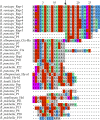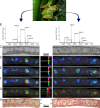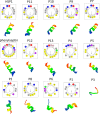Cleavage of Peptides from Amphibian Skin Revealed by Combining Analysis of Gland Secretion and in Situ MALDI Imaging Mass Spectrometry
- PMID: 30023919
- PMCID: PMC6044630
- DOI: 10.1021/acsomega.7b02029
Cleavage of Peptides from Amphibian Skin Revealed by Combining Analysis of Gland Secretion and in Situ MALDI Imaging Mass Spectrometry
Abstract
Peptides from skin secretions of amphibians are considered important components of their immune system and also play a relevant role in their defense mechanism against predators. Herein, by using mass spectrometry (MS), we characterize the sequence of 13 peptides from the gland secretion of the hylid tree frog, Boana punctata. Using in situ matrix-assisted laser desorption ionization imaging MS of a transverse section of the skin tissue, we show that some peptides are stored as longer molecules that are cleaved after being secreted, whereas others do not undergo any modification. Sequence comparison with peptides from other Boana species and analysis of the three-dimensional theoretical structure indicate that this cleavage depends on both the presence of a specific sequence motif and the secondary structure. The fact that peptides undergo a rapid cleavage upon secretion suggests that stored and secreted peptides may have distinct roles for anuran survival, including defense against pathogens and predators.
Conflict of interest statement
The authors declare no competing financial interest.
Figures




References
-
- Aksenov A. A.; da Silva R.; Knight R.; Lopes N. P.; Dorrestein P. C. Global chemical analysis of biology by mass spectrometry. Nat. Rev. Chem. 2017, 1, 0054.10.1038/s41570-017-0054. - DOI
-
- Erspamer V.Bioactive secretions of the amphibian integument. In Amphibian Biology; Heatwole H., Barthalmus G. T., Eds.; Surrey Beatty & Sons: Chipping Norton, 1994; pp 178–350; Vol. 1: The Integument.
LinkOut - more resources
Full Text Sources
Other Literature Sources

